Meeting news from around the world.
Category Archives: Main article
Meeting News from London by Padmassana
September 2005 London meeting. Globies kicked off the new
season at our temporary venue The Concert Artists Association on
the other side of Covent Garden. Jules Stewart
started the season with his talk on the Northwest frontier area
of Pakistan. He told us about the history of the area, which
still has a large tribal element. Jules showed us the
Khyber Pass and explained the arrangements needed to explore the
pass, including getting a permit and a man with a gun to
accompany him up to the arch. (The Beetle also did this, same
thing: man and a gun.) We saw the monument to allied forces
killed defending the pass. We also saw the city of Peshawar
(a city Padmassana remembers only for the ceiling of the hotel
thanks to some dodgy food!) it was good to see what the city has
to offer visitors. Thanks to Jules for an interesting talk.
After the break, Juliet Coombe took us to post tsunami Sri
Lanka, after a few shots of the usual tourist places she showed
us the aftermath of the devastation. After seeing the
events unfold Juliet felt moved to do more than be an observer,
so flew out with her rudimentary first aid training to help in
any way she could. She helped doctors clean wounds and we
also saw difficult images of bodies being recovered. Later
she became involved in helping the children, first by having
paper and pens sent over from Australia and later letting them
use disposable cameras to help them understand and come to terms
with their loss. The train swept away at Galle is
remembered by everyone in the west, the children were fearful of
getting back on a train, but with Juliet’s camera’s they
overcame their fears and boarded a train again.
Globetrotters had a collection which raised £104 for her Perailya.com
charity.
Next month’s London meeting will be held on Saturday 1st
October.
Venue Change
Unfortunately, the building works at the Church of Scotland are
continuing and we are on the move again this month, this time to
a new venue near Holborn. We hope to be back to the normal venue
for the November meeting, builders permitting.
The October meeting will be held at Covent Garden Dragon
Hall, 17 Stukeley Street, London WC2B 5LT at 2.30pm
Website and map: www.dragonhall.org.uk
Neil Taylor will be talking about “Estonia,
Tallinn and the Baltic Capitals.” Neil is a Bradt author,
recognised for opening up the communist world to tourism and
regular traveller to Estonia. See:
www.bradtguides.com and Stevie Smith will be
talking about “Peddling to Hawaii” – a human powered
adventure across the Western Hemisphere. Picture a
frustrated office worker of twenty-five. He resolves to
grab life with both hands and embark on a thrilling adventure: to
go around the world by human power. With no prior
experience and no money, Stevie and his friend Jason managed to
cycle down through Europe, cross the Atlantic Ocean in 111 days
in a purpose-built pedal boat, cycle and skate across the USA and
pedal over the Pacific to Hawaii. Pedalling to Hawaii is
hilarious and refreshingly non-heroic, packed with thrills and
spills. It is also an inspiring account of a search for
simplicity and freedom. Stevie Smith is continuing with the
expedition. Discovery Networks Europe have broadcast three
documentaries about the journey .
London meetings are held at The Church of Scotland, Crown
Court, behind the Fortune Theatre in Covent Garden
at 2.30 pm on the first Saturday of each month.
There is no London meeting in August, but we will
be back in September. For more information, you can contact the
Globetrotters Info line on +44 (0) 20 8674 6229, or visit the
website: www.globetrotters.co.uk
Admission Members £2.50 Non-members £5
Overseas Meetings
We used to have meetings in New York City and New Braunfels, Texas. Regrettably, after having done a superb job, neither organisers are able to give their time to Globetrotter meetings. If you are based in New York or New Braunfels and have the time to commit to pick up where our previous organisers left off, we'd love to hear from you – please see our FAQ or contact our the Branch Liaison Officer via our Website at Meeting FAQ. If you are based elsewhere and are interested in starting a branch of the Globetrotters, please feel free to contact us.
Meeting News from Ontario
For information on Ontario meetings, please contact Svatka Hermanek: shermanek@schulich.yorku.ca or Bruce Weber: tel. 416-203-0911 or Paul Webb: tel. 416-694-8259.
Meetings are held on the third Friday of January, March, May, September and November. Usually at the Woodsworth Co-op, Penthouse, 133, Wilton Street in downtown Toronto at 8.00 p.m.
Greg McKenzie's Motorbike Travels from Rio Gallegos to Ushuaia
 Trip duration: 19 days
Trip duration: 19 days
Trip miles to date: 3,040
Miles since last update: 1,023
I've recently arrived in Peurto Natalès having successfully visited Ushuaia and the end-of-the-world!!! Having hoped to make Ushuaia in a single leap from Rio Gallegos, I had to overnight in Rio Grande (150 miles short) as 2 border crossings and a delayed ferry crossing (across the Straights of Magellan) slowed progress.
The borders were remarkably trouble-free and I'm thankful for getting the correct documentation (Carnet de Passage for the bike) prior to travelling. It's also a bonus that many bikers come through these borders on route to Ushuaia so the officials know what they're looking at – although I'm still impressed with the flamboyance and enthusiasm you can put into stamping a document 6 or 12 times.

Any thoughts of reaching Ushuaia that night were dashed at the ferry crossing at Pta. Delgardo, which connects mainland Chile with Terra del Fuego. Even by Pategonian standards, it was pretty bloody windy that day and the ferry ramp on the other side was closed. I joined a long-line of traffic and had to park the bike behind other vehicles to prevent it from being blown over!
With little information forthcoming, many vehicles turned around and headed south (I guess) to Punta Arenas and the longer ferry crossing. The other frustration was that trucks and coaches automatically drove to the head of the queue, taking priority over the proletariat like me. Of course everybody else could take shelter in their cars / vans / 4×4's etc – but for me it was a couple of hours sitting on the tarmac in the lee of the wind.
 Eventually, 3 hours after arriving,
I got to board a ferry. Naturally I was pulled aside and
loaded last, squeezed on between a rental car and the now raised
loading ramp. I didn't share the loaders confidence in
the position of the bike so I decided to stay on the bike for the
incredibly bumpy 20 minutes it took to cross – if I hadn't
the bike would have fallen against the car for sure.
Eventually, 3 hours after arriving,
I got to board a ferry. Naturally I was pulled aside and
loaded last, squeezed on between a rental car and the now raised
loading ramp. I didn't share the loaders confidence in
the position of the bike so I decided to stay on the bike for the
incredibly bumpy 20 minutes it took to cross – if I hadn't
the bike would have fallen against the car for sure.
The blast down to San Sebastian (2nd border) was fun as it was dirt road all the way and I was able to catch, and pass all the traffic from both the ferry I was on, and the previous ferry that was full of vehicles that had driven past me in the queue (very satisfying!!!)
After over-nighting in Rio Grande I struck out for Ushuaia the next day. Pleasingly the terrain changed from the flat open pampas to forested mountains. The last 20 miles changed from dirt track to beautiful tarmac, which wouldn't have been out of place along the Route Napoleon outside Nice.
Eventually I rounded a corner and there it was – USHUAIA!!! It amuses me that after 2,000 miles this marks the start of my stated trip to Alaska.

From the gentle slope down into the town, I could see several ships in port ahead. Little did I appreciate what this really meant. Upon parking on the high street in search of a hotel list I was immediately approached by several Brit tourists – drawn by the Union Jack on my crash helmet. This was pleasant enough but it highlights the type of town Ushuaia is, a transit lounge for wealthy western tourists on route to a short trip around Antarctica. Ushuaia was quite unlike any other town in Argentina, full of tacky souvenir shops, Irish theme pubs and expensive hotels.
After spending a night at the (very welcoming) Hostel Albergue I decided to get out of town, choosing to camp in the remarkably picturesque Nation Park of Terra del Fuego, which coincidentally also contains the official end of the road.
I dutifully posed for the obligatory photo next to the wooden
marker (see below) before setting up camp (first time
on the trip). The park is stunning and the following day I set
off early to climb the highest peak there (yeah, a bit foolhardy
I know). The trails were easy to follow but the climb was a
tricky one, rising through incredibly dense forest, sat points
resembling something out of Hansel & Gretal, into peat bog
and eventually a tall slope of loose scree.
before setting up camp (first time
on the trip). The park is stunning and the following day I set
off early to climb the highest peak there (yeah, a bit foolhardy
I know). The trails were easy to follow but the climb was a
tricky one, rising through incredibly dense forest, sat points
resembling something out of Hansel & Gretal, into peat bog
and eventually a tall slope of loose scree.
The summit view was worth the toil (photo above) showing all around the Beagle Channel and off into Chile and Cape Horn itself.
Next day I set off north, aiming to stop in Punta Arenas. Another border, another ferry across the Magellan Straights, and once more I'm in Chile. At the ferry ramp at Porvenir I was entertained by 10 Czech engineers on route to James Ross Island to build the Czech Republic's first research station in Antarctica. Amusingly they were more impressed at my trip than their own forthcoming endeavour, but having just read about the fateful trip of Shackleton's expedition to that area, I'm in awe of anybody who elects to spend a lengthy stay there. One of them had contacts with the Czech version of Motorcycle News (magazine) and took my details and a photo for the journal.
So now I'm in Peurto Natales and about to embark on a 6 day trek around the Torres del Paine national park. This was a must do excursion for me before the trip and from what I can see of the Andes rising from the horizon, I wont be disappointed.
I'm 3,000 miles and 20 days into this trip and getting used to the change of lifestyle. What I have noticed is the western-world (and specifically US) 'culture-creep'. Every hotel I check into has 60 channels of TV with predominately US content spilling out and it inevitably impacts the local environment.
I wonder what this trip would find if it were repeated 50 years from now.
If you want to know more about Greg's travels, visit his website at: http://www.unbeatentrack.com/
Destination Guide – Trieste by Karen Bryan
Trieste is an Adriatic coastal city in north eastern Italy, close to the border with Slovenia. The sea in the Gulf of Trieste is very clear and clean, with limestone cliffs and rocky beaches. The centre of the city has a mid-European feel, more Austrian than Italian, Trieste was the seaport of the Hapsburg Empire. Here you can enjoy a combination of a sea/beach holiday and the attractions of a cultural city.
It is an ideal destination for a short break but you could easily spend a week here. The Verdi Theatre hosts an opera season in the winter and an operetta festival in summer. You can swim in the beautiful clear sea, stroll the promenade, and walk along the cliff paths. Take in the wonderful art collection at the Revoltella Museum. You can sip coffee on Piazza Unita Italia with its grand 19th century buildings, which face onto the sea.
History: according to folklore, Trieste was founded by Tergeste, a friend of Jason and the Argonauts. Ancient Tergeste as a Roman colony is dated to around 178 BC. It became more important during the reign of Octavian when roads were improved. The city has had many rulers during its history: Goths, Byzantines, and Lombards. In the 13th century Trieste was forced to swear allegiance to Venice. To escape Venetian domination, Trieste sought the protection of Duke Leopold of Austria. Trieste was of great importance to the Hapsburg Empire as a seaport and was made a Freeport in 1719. Without customs barriers the port and city flourished. At the end of the First World War with collapse of the Hapsburg Empire, Trieste was returned to Italy in 1918. Trieste was taken over by the Third Riech when Italy withdrew from the Second World Ward in September 1943. Two years later there was a 40-day Occupation by Tito's Yugoslav forces. After 9 years under an Anglo-American government Trieste was handed over to the Italian government.
Trieste's history may help explain why 70% of Italians apparently did not know that Trieste was part of Italy in a recent opinion poll! With EU enlargement Trieste is ideally placed as the only natural port in the centre of Europe. Trieste is one of three finalists to host the international Expo of Science, Technology and Culture in 2008. If its bid is successful there will be more investment in the area and Trieste will become better known on the world map.
Literary Connections: the Irish author James Joyce lived
in Trieste during the early part of the 20th century. When he
first arrived he worked as a tutor at the Berlitz School of
English. He went on to write “The Dubliners”, “The
Portrait of an Artist as a Young Man” and start
“Ulysses” in Trieste. The rich mix of central European
and Eastern Mediterranean culture in Trieste is said to have had
a great influence on his writing.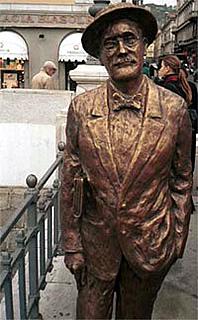
Joyce (pictured left) was English tutor to Itali Svevo, the Italian novelist. Svevo was born in Trieste in 1861, his Mother was part of a Triestian Jewish family, and his Father was of German descent. Joyce encouraged and praised Svevo's work and Svevo wrote critiques of Joyce's work.
Jan Morris wrote the book, “Trieste and the Meaning of Nowhere”. Morris claims this is her final book, a self-examination based in Trieste. Morris changed gender. Jan Morris first visited Trieste at the end of the Second World War as young Welsh soldier. She describes how the city “curiously haunted her” . She revisited the city as an elderly woman.
Morris describes Trieste as “natural capital of the nation of nowhere”. By this she means a home for the so-called “Fourth World”. This is a scattered group with the common values of humour and understanding, usually exiles in their own communities but probably numerous enough to form their own nation.
I laughed at Clay Risen's comment in his piece about Trieste in the Square Table in Spring 2003. He observed that “Trieste is the only city in Europe which appears more often in reflective essays than in guide books of newspaper travel sections.”
Exploring the city: the best way to explore the city is to walk around. The Piazza dell' Unita d'Italia is the heart of the city. The square was created towards the end of the 19th century. It houses the City Hall, with its clock tower featuring statues of Mikeze and Lakeze, figures from Trieste folklore; Government House, with its gilded mosaic wall decorations; and the former Head Office of Lloyd Triestino, built in Renaissance style by an Austrian architect.
The Victory Lighthouse lights the Gulf of Trieste and commemorates the dead of the First World War. It stands almost 70 metres high with a scaled dome containing a statue of winged Victory. At the base of the column is the anchor of the torpedo boat Audace, the first Italian ship to enter the harbour in 1918. The lighthouse took 4 years to complete and was officially opened in 1927.
The Old Stock Exchange (see picture right) is a fine example of
neo-classical architecture, resembling a Greek temple. The Old
Stock Exchange stands by the so called Grand Canal. However this
is rather a misnomer as the canal is very short.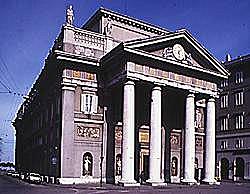
The Arco di Riccard is a Roman gate to the city thought to date from 33 AD. It is in Piazzetta di Ricordo in the old city. You can see the Roman amphitheatre at the foot of San Guisto hill. The Verdi Opera Theatre opened in 1801. It is of a similar style to La Scala in Milan. The Arco di Riccard is a Roman gate to the city thought to date from 33 AD. It is in Piazzetta di Ricordo in the old city. You can see the Roman amphitheatre at the foot of San Guisto hill. The Verdi Opera Theatre opened in 1801. It is of a similar style to La Scala in Milan.
Day Trips: there are many day trips that can be taken, including exploring the Carse. The Triestine carse starts at Montefalcone in the north and stretches down adjacent to the Slovenian border. The area is known as a paradise for botanists with a mixture of continental flora and Mediterranean vegetation. There is talk of the area achieving national park status. The Carsic house in Rupingrande has a collection of traditional furniture and local costumes. During the first week in May the works of local painters are exhibited during the Majence Festival, in San Dorligo delle Valle. The best known event is the Carsic Wedding, every second year on the last Sunday of August in Monrupino. There are dances every night of the preceding week. On the wedding day the bridal procession, all dressed in traditional costume, walk to the fortress church for the marriage ceremony.
Grado and Aquiliea : Aquiliea was founded in the first century BC. It occupies a strategic defence location. It became a Patriarch's seat and many beautiful churches were built. The Bascilica is considered to be one of the most important monuments of early Christianity. There are two museums to visit there.
Grado was the extreme southern part of the port of Aquileia (see
picture below left). Now it a beautiful island city joined to the
mainland by a causeway. It boasts 20 kms of fine sandy beaches.
Grado was very popular as a spa during the days of the Austrio
Hungarian Empire with its healing sands.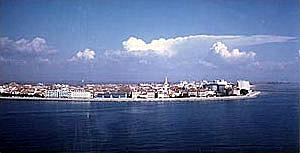 Grado can be reached by the no 21
bus from Trieste. There is also a boat service during the Summer.
Grado can be reached by the no 21
bus from Trieste. There is also a boat service during the Summer.
Muggia: Muggia (see picture below right) is a pretty coastal town just south of Trieste, which can be reached by ferry from Trieste during the summer. The town is of Venetian origin, surrounded by medieval walls with a 14th century castle and a pretty port.
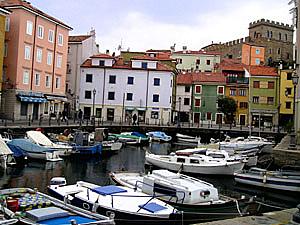 The Slovenian border is just a few
kilometres from Trieste. The Lipica Stud and
Riding School is under a half hour drive from Trieste. It was
originally founded in 1580 by Archduke Charles for breeding royal
horses for the Austrian court. Now you can tour the stud farm (6
Euros) or have a riding lesson, starting at 16 euros.
The Slovenian border is just a few
kilometres from Trieste. The Lipica Stud and
Riding School is under a half hour drive from Trieste. It was
originally founded in 1580 by Archduke Charles for breeding royal
horses for the Austrian court. Now you can tour the stud farm (6
Euros) or have a riding lesson, starting at 16 euros.
Croatia can be easily reached through by passing through the narrow strip of coastal Slovenia. Venice can be reached by direct train from Trieste. The journey takes around two hours. The train takes you right into the centre of Venice.
Getting there and around: Ryanair flies into Trieste from London Stansted. The airport is 35 kms west of Trieste but there is regular public transport on Coach 51 into Trieste. If you do decide to hire a car, it is worth checking that you can take it into Slovenia and Croatia if you are considering day trips there. Trieste has a good public transport network. There is a “Trieste by Bus” city tour in 13 stops. This is available on Saturdays and Sundays at 2pm from the end of June to mid October. The two and a half hour trip allows you to see the city's main attractions. The cost is around five euros per person. You can take the Opicani tram up to the Carso plateau, 348 metres above sea level. This funicular tramway was built in 1902. The tram leaves from Piazza Oberdan in the city centre up Scorolo hill to the plateau above.
Karen Bryan is an independent travel consultant and writer, specialising in less well known destinations in Europe. Her websites are: www.europealacarte.co.uk, www.europe-culture-activity-tours.com
The Legend of Sangkuriang by Tedy
West Java is one of the five provinces of Java, Indonesia. Bandung is the capital city. The greater part of west Java is mountainous, with the Priangan highlands forming the core territory. 21 mounts can be found here, most of which are classified as active volcanoes and have become an integral part of tourism in the West Java province.
Mount Tangkuban Perahu (capsized boat) is one of them. A smouldering 2000m wide, surrealistic volcano 1800m above sea level, it lies 28 km north of Bandung reachable within 30 minute ride.
The Legend of Sangkuriang
This is an example of how nature was converted into a legend, such as Bandung lake and Mt Tangkuban Perahu with the story of Queen Dayang Sumbi and her son Sangkuriang cited from Neuman va Padang (1971). Once Sangkuriang, whilst growing up, he was so naughty and got hurt and the wound formed an ugly scar.
The King, who loved his son above everything was so furious that his son had hurt himself that he rejected his wife. Fifteen years later, being of age, Sangkuriang asked his father permission to take a trip to West Java. After arriving in the plain of Bandung, he met a beautiful lady, fell in love and ask her to marry him and she accepted. But one day when she caressed her lover's head she saw the wound. The loving woman, turned out to be the disowned queen, discovered that she was in love with her son and marriage was impossible.
The marriage had to be prevented. Not willing to admit that she was his mother she thought of a way out. The day before the wedding was due to take place, she said to her husband to be, tomorrow is our wedding day, and if you are true to your love to me and love me as much you say do then I want to celebrate the wedding on board a ship, a proa. Tomorrow morning at day break, I want to sail with you on a great lake in a nice boat and there must be a banquet feast. Sangkuriang was embarrassed but he was not willing to refuse. He begged the help of the lake's helpful spirits. By causing a landslide, the lake spirit dammed the river Citarum that flowed through the plain of Bandung. The force of the water felled big tree and a boat was constructed while other lake spirits prepared the wedding banquet.
Early in the morning the Queen saw that the impossible had been realised so she prayed to Brama, the mighty God, to help her to prevent the disgrace of a marriage between a mother and her son. Brama destroyed the dam in turbulence and Sangkuriang was drowned. The queen in her agony threw herself on the capsized boat, breaking through the hull of the ship and was also drowned.
Now, the vast plain of Bandung is flanked on its north side by the volcano Tangkuban Perahu, the capsized boat. The Queen's jump on the hull of the ship is the Kawah Ratu, the crater of the Queen. The hot fumaroles and tremors in the crater represent the tears of the sad mother still sobbing. East of Mt Tangkuban Perahu rises the Bukit Tunggul, trunk mountain, the trunk of the tree from which the boat was made and to the west we find Mt Burangrang, the “crown of leaves”. At many places along the shore of the lake Neolithic obsidian tools of primitive inhabitants are found and described by von Koeningswald (1935). These Neolithic people noticed that the hold was cut deeper and deeper by erosion caused by the lowering water. Finally only a marshy plain remained.
Centuries later the inhabitants of Bandung plain still know about the legend of the existence of a former lake. Not knowing anything about geology, but living in the taboos of spirit ghosts and Gods, geological facts were put together in a tale that was understandable.
If you are thinking of holiday trip, or even just information on any travel requirements in Java especially Indonesia, please do not hesitate to contact me. I'll be most happy to assist you. Tedy can be contacted by e-mail as follows: abctour_td@cbn.net.id.
Wilding in Southwest USA
A group of US researchers at Cornell University have identified a novel approach to conservation called Pleistocene wilding. They have developed an initiative that involves placing lions, cheetahs, elephants and camels in some parts of North America.
The plan would help endangered African animals while offer ecotourism and land-management jobs to help the struggling economies of the Great Plains and Southwest as well as helping to maintain ecosystems and boost biodiversity.
During the Pleistocene age, between 1.8 million to about 10,000 years ago, North America was home to a wide range of mega fauna. When man arrived around 13,000 years ago he hunted the American cheetah and a type of camel to extinction. The disappearance of these extinct creatures has left gaps in the ecosystem. The pronghorn, for example, which exists today, an antelope-like animal for example has lost its natural predator.
By introducing living counterparts to the extinct animals, the researchers say, these voids could be filled. So, by introducing free-ranging African cheetahs to the Southwest, strong interactions with pronghorns could be restored, while providing cheetahs with a new habitat. Other living species that could “stand in” for Pleistocene-era animals in North America include feral horses, wild asses, Bactrian camels, Asian and African elephants and lions.
“Obviously, gaining public acceptance is going to be a huge issue, especially when you talk about reintroducing predators,” said lead author Josh Donlan, of Cornell University. “There are going to have to be some major attitude shifts. That includes realising predation is a natural role, and that people are going to have to take precautions.” Dr Donlan said that large tracts of private land are probably the most promising place to start, with each step carefully guided by the fossil record and the involvement of experts and research.
“We are not advocating backing up a van and letting elephants and cheetah out into the landscape,” he said. “All of this would be science driven.”
Advice on Booking Airfares by Corsa Dirfes
Need a vacation but don't want to stay around town? Want to go somewhere exotic, somewhere different? Want to fly but worried about the airfare? Sourcing the cheapest airfare available has been made easier with competition growing between travel agencies as people realize that a vacation need not be all that expensive. With so many travel companies vying for your business, securing a cheaper airfare is a given!
The airline companies set airfare prices, with travel agents adding a mark up to the wholesale price. You should always check whether the advertised price of an airfare includes government taxes or duties, so you may need to add these into your airfare budget.
Aside from the airline companies and travel agencies setting the price, it is important to be aware that many things determine airfare prices, but the most important influence on price is the final destination. Other influences include but are not limited to:
- The type of airline class you prefer; do you want comfort or are you ok with being a tad squashed
- The location of your seat; window seat or inside
- The time of day you are prepared to travel; day or night
- How close you book to your departure date – booking closer to your departure date may increase your airfare unless you secure a last minute deal
- Whether your airfare is part of an all inclusive holiday package; more often than not for these all inclusive packages the airfare has been given with a huge discount as a deal between the resort or hotel, the airline and travel agent.
Therefore, being the money savvy person that you are, you should take into consideration all of the above points before you start searching for an airfare that fits within your budget. Researching airfare is critical to securing the cheapest rate and these days, research is made a good deal easier thanks to the internet.
Increasingly, last minute deal websites are being developed and there are some great bargains to be had particularly with regard to airfare rates. Checking often and subscribing to these last minute deal web sites will ensure that your vacation is one to remember without the added burden of over spending on airfare!
Corsa Dirfes is the owner of http://www.airfareson.com which is a premier resource for Airfares information. For more information, go to http://www.airfareson.com
Almost Meeting the Fish in Bali by Iona Hill
I can totally understand why people rave about Bali – a truly wonderful place – loved it – so serene – and very quiet. I took a flight from London to Singapore that took 12 hours, then a 2 hour wait in Changi – could be far worse places to wait! And off to Bali, on a low cost airline, Australian Airlines. It only took 2 hrs 5 mins, so only a hop and a good airline experience.
We were met at Depensar airport around 10pm by a very good natured man from the resort I'd booked and we transferred in an air con'd jeep that had seen better days to the north part of Bali, cutting through the mountains, past dark reflective lakes and rice terraces, past lush rain forest and neat houses adjoining the road and the silhouettes of Hindu temple after temple. Even in the dark, it all looked very clean and fascinating. It took two and a half hours, but we were later to realise that this was a very good time to do the transfer as during the day, the roads are unbelievably congested with men on motorbikes, men and whole families concertina-d on motorbikes, men and women riding side saddle on motorbikes, small stall holders with their wares on motorbikes, ancient lorries dripping with all manner of contents churning to get up hills and the odd short mini bus, but no tourists.
Got to the hotel about 1am, full of beans and explored the grounds, saw the sign saying do not feed the monkeys, dipped my toes in one of many hot springs and was up early the next day to sort out diving.
The place we stayed in had several natural hot spring pools: some really, really hot, some just very hot and some varying between just right to cold – total bliss. After 2 nights of staying in a very nice room, with a semi open air bathroom surrounded by tropical plants, I came back from diving and was met by a very excited friend, Marian, who told me that we had been upgraded to our own villa with its own hot spring tub kind of thing. It was very posh, and we spent hours in our own little natural spring hot tub in our own courtyard surrounded by tropical flowers and banana, mango and papaya trees – total bliss!
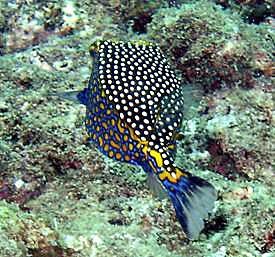 Very good
diving, all drift diving, some strong currents, including down
currents – hhhmm – oh, and dynamite fishing whilst we were in the
water! This was a little scary. The previous day we'd been
out diving around Menjangen Island when we unexpectedly came
across several men diving along side us, breathing in compressed
air from an umbilical cord leading from a boat on the surface.
They had a couple of weights wrapped around their waist but no
other safety equipment, like a gauge to tell them how deep they
were or how long they'd been in the water.
Very good
diving, all drift diving, some strong currents, including down
currents – hhhmm – oh, and dynamite fishing whilst we were in the
water! This was a little scary. The previous day we'd been
out diving around Menjangen Island when we unexpectedly came
across several men diving along side us, breathing in compressed
air from an umbilical cord leading from a boat on the surface.
They had a couple of weights wrapped around their waist but no
other safety equipment, like a gauge to tell them how deep they
were or how long they'd been in the water.
This is extremely dangerous, as they were doing hideous dive profiles, see-sawing up and down is a great way to get air embolisms, not to mention the bends if you are in the water too long. Not only were they carrying spear guns, but they were stealing tiny baby colourful tropical fish – for sale in aquariums. The three pictures show a baby puffer fish and a clown anemone fish, both the type these pirates were trying to catch.
They had long metal rods and were poking around behind coral and in the crevices, they knew exactly what they were after – baby lion fish and butterfly fish, but very, very small ones. They coaxed or frightened them out from their hiding places, caught them in a butterfly kind of net and then put them into plastic bags and tied them to themselves. It was not a good sight.
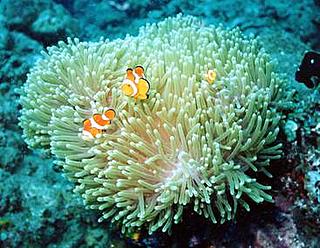 This was not
quite in the protected WWF marine reserve where I mostly dived,
but they most definitely should not have been doing this. They
were no more pleased to see us than me and the dive instructor I
was with, were to see them. They knew they were 'in the
wrong' and it was a very awkward situation under water, a
little aggressive and certainly very threatening. When we got
back to our dive boat, and were returning to our hotel, the
Japanese instructor (a tiny little thing, with the strength of
Goliath) said in Indonesian (which I picked up a fair bit of!) to
the guys on the pirate boat that she was going to call the
police. They were not impressed.
This was not
quite in the protected WWF marine reserve where I mostly dived,
but they most definitely should not have been doing this. They
were no more pleased to see us than me and the dive instructor I
was with, were to see them. They knew they were 'in the
wrong' and it was a very awkward situation under water, a
little aggressive and certainly very threatening. When we got
back to our dive boat, and were returning to our hotel, the
Japanese instructor (a tiny little thing, with the strength of
Goliath) said in Indonesian (which I picked up a fair bit of!) to
the guys on the pirate boat that she was going to call the
police. They were not impressed.
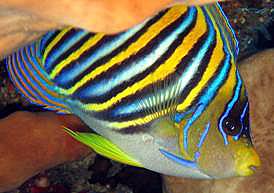 The next day
we dived in a different part of the same marine sanctuary, when
we heard this massive boom. There is only one sound, that, even
under water sounds like that – explosives. I was rather scared,
to put it mildly! Someone close by was dynamite fishing. It was
not a good feeling, and I thought that maybe, just maybe, my time
was up, and this is how it was all going to end – making enemies
with Indonesians stealing tropical fish who dynamited us out of
the water for revenge. But, as you can see, they did not dynamite
us, but there were four explosions on that dive and they were
further away than I first thought, but it was still very scary,
the whole water and landscape seems to vibrate and shake, almost
as if it was crying.
The next day
we dived in a different part of the same marine sanctuary, when
we heard this massive boom. There is only one sound, that, even
under water sounds like that – explosives. I was rather scared,
to put it mildly! Someone close by was dynamite fishing. It was
not a good feeling, and I thought that maybe, just maybe, my time
was up, and this is how it was all going to end – making enemies
with Indonesians stealing tropical fish who dynamited us out of
the water for revenge. But, as you can see, they did not dynamite
us, but there were four explosions on that dive and they were
further away than I first thought, but it was still very scary,
the whole water and landscape seems to vibrate and shake, almost
as if it was crying.
Apart from the dynamite fishing, I can whole heartedly recommend the unvisited northern and north east part of Bali, it's beautiful, the people serene, friendly and a privilege to have spent time there.
